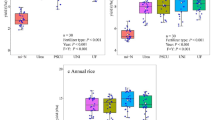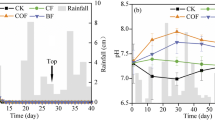Abstract
A survey on current fertilizer practices and their effects on soil fertility and soil salinity was conducted from 1996 to 2000 in Beijing Province, a major vegetable production area in the North China Plain. Inputs of the major nutrients (NPK) and fertilizer application methods and sources for different vegetable species and field conditions were evaluated. Excessive N and P fertilizer application, often up to about 5 times the crop requirement in the case of N, was very common, especially for high-value crops. Potassium supply may have been inadequate for some crops such as leafy vegetables. Urea, diammonium orthophosphate ((NH4)2HPO4) and chicken manure were the major nutrient sources for vegetable production in the region. Over 50% of N, 60% of P and nearly 90% of K applied originated from organic manure. Total N application rate for open-field Chinese cabbage from organic manure and inorganic fertilizers ranged from 300 to 900 kg N ha–1 on 78% of the farms surveyed. More than 35% of the surveyed greenhouse-grown tomato crops received > 1000 kg N ha–1 from organic and inorganic sources. A negative K balance (applied K minus K removed by the crop) was found in two-thirds of the surveyed fields of open-field Chinese cabbage and half of the surveyed fields of greenhouse-grown tomato. Plant-available N, P and K increased with increasing length of the period the greenhouse soils had been used for vegetable production. Similarly, soil salinity increased more in greenhouse soils than in open-field soils. The results indicate that balanced NPK fertilizer use and maintenance of soil quality are important for the development of sustainable vegetable production systems in this region.
Similar content being viewed by others
References
Chen Q., Zhang H.Y., Tang L.L., Li X.L. and Liebig H.P. 2002. Effects of water and nitrogen supply on spinach (Spinacia oleracea L.) growth and soil mineral N residues. Pedosphere 12:171–178.
Extension Service Center, Ministry of Agriculture 1989. Balanced fertilization in vegetable production. Agriculture Press, Beijing, China (in Chinese).
Fageria N.K. 2002. Soil quality vs. environmentally-based agricultural management practices. Commun. Soil Sci. Plant Anal. 33:2301–2329.
Lorenz H.P., Schlaghecken J., Engl G., Maync A. and Ziegler J. 1989. Ordnungsgemùβe Stickstoff-Versorgung im Freiland-Gemüsebau-KNS System. Ministerium für Landwirtschaft, Weinbau und Forsten, Rheinland Pfalz, Germany.
Motavalli P.P., Lory J.A., Nathan M.V. and Fulcher C. 2002. Increased access to soil testing database through the world wide web: opportunities and issues. Commun. Soil Sci. Plant Anal. 33: 1157–1171.
Neeteson J.J., Booij R. and Whitmore A.P. 1999. A review on sustainable nitrogen management in intensive vegetable production systems. Acta Hort. 506: 17–26.
Nye P.H. and Tinker P.B. 1977. Solute Movement in the Soil-Root System. Studies in Ecology, Vol. 4. Blackwell Scientific, Oxford, UK.
Sørensen J.N. 1996. Improved N efficiency in vegetable production by fertilizer placement and irrigation. Acta Hort. 428: 131–139.
Tinsley J. 1950. Determination of organic carbon in soils by dichromate mixtures. In: Trans. 4th Int. Congr. Soil Sci. Vol. 1. Hoitsemo Brothers, Groningen, the Netherlands, pp. 161–169.
Stanley C.D., NcNeal B.L., Gilreath P.R., Creighton J.F., Graham W.D. and Alverio G. 1995. Nutrient loss trends for vegetable and citrus fields in west-central Florida: II. Phosphate. J. Environ. Qual. 24: 101–106.
Wehrman J. and Scharpf H.C. 1989. Reduction of nitrate leaching in a vegetable farm: fertilization, crop rotation, plant residues. In: Germon J.G. (ed.), Management Systems to Reduce Impact of Nitrates. Elsevier, London, UK, pp. 147–157.
Weier U., Van Riesen U. and Scharpf H.C. 2001. Nil-N-plots: a system to estimate the amount of the nitrogen top dressing of vegetables. Acta Hort. 563: 47–52.
Author information
Authors and Affiliations
Rights and permissions
About this article
Cite this article
Chen, Q., Zhang, X., Zhang, H. et al. Evaluation of current fertilizer practice and soil fertility in vegetable production in the Beijing region. Nutrient Cycling in Agroecosystems 69, 51–58 (2004). https://doi.org/10.1023/B:FRES.0000025293.99199.ff
Issue Date:
DOI: https://doi.org/10.1023/B:FRES.0000025293.99199.ff




